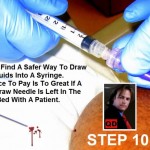 What if the safer device that I choose is on back order? Safety equipment must be available at all times. If for some reason an engineering control is not available (due to supply shortages, back orders, shipping delays, etc.), this must be documented in your Exposure Control Plan. You would then be responsible to implement the chosen control(s) as soon as it becomes available and adjust your exposure control plan to illustrate such. In the meantime, work practice controls must be used and, if occupational exposure still remains, personal protective equipment must also be used.
What if the safer device that I choose is on back order? Safety equipment must be available at all times. If for some reason an engineering control is not available (due to supply shortages, back orders, shipping delays, etc.), this must be documented in your Exposure Control Plan. You would then be responsible to implement the chosen control(s) as soon as it becomes available and adjust your exposure control plan to illustrate such. In the meantime, work practice controls must be used and, if occupational exposure still remains, personal protective equipment must also be used.
Do I have to keep a sharps injury log? Does it have to be confidential?
If, as an employer, you are required to maintain a log of occupational injuries and illnesses under 29 CFR 1904, you must also establish and maintain a sharps injury log for recording percutaneous injuries from contaminated sharps. The Sharps Log must contain, at a minimum, information about the injury, the type and brand of device involved in the injury (if known), the department or work area where the exposure occurred, and an explanation of how the incident occurred. The log must be recorded and maintained in such a manner so as to protect the confidentiality of the injured employee (e.g., removal of personal identifiers).
Does the revised Bloodborne Pathogens Standard apply to medical or dental offices that have fewer than 10 employees?
OSHA’s Bloodborne Pathogens Standard applies to all employers with employees who have occupational exposure to blood or other potentially infectious materials (OPIM), regardless of how many workers are employed. However, workplaces with 10 or fewer employees are exempt from OSHA recordkeeping requirements and are also exempt from recording and maintaining a Sharps Injury Log. (See 29 CFR 1904 for applicability of recordkeeping requirements). All other applicable provisions of the Bloodborne Pathogens Standard still apply.
What new information do I need to include in my written Exposure Control Plan?
How often to I need to update it? In addition to what is already required by the 1991 standard, the revised standard requires the documentation of (1) annual consideration and implementation of appropriate engineering controls, and (2) solicitation of non-managerial healthcare workers in evaluating and choosing devices. The plan must be reviewed and updated at least annually.
Where can I get information about what is expected of me?
There are several resources available for employers and employees with regard to occupational exposures to blood and OPIM. First, of course, is the OSHA Bloodborne Pathogens Standard (29 CFR 1910.1030). Also available are “CPL 2-2.69 (November 2001). Enforcement Procedures for the Occupational Exposure to Bloodborne Pathogens, and many other related documents. You may access this information, as well as information from OSHA’s Consultation and State Plan State Offices, via OSHA’s website at http://www.osha.gov or by phone at 1-800-321-OSHA. The National Institute for Occupational Safety and Health (NIOSH) and the Centers for Disease Control and Prevention (CDC) also have several documents related to the prevention of occupational exposure to blood and OPIM.
Original post:
Do We Have To Keep A Sharps Injury Log?